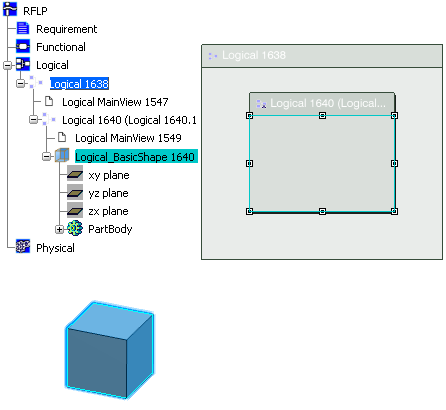- In the 2D grapp, select the logical component in which you want to create a shape.
A context toolbar appears next to the logical component:  Note:
The yellow symbol on each shape indicates that these commands create 3D geometry only.
- In the context toolbar, select the type of shape you want to create:
-
 Box Box -
 Cylinder Cylinder -
 Sphere Sphere -
 3D Shape. 3D Shape.
A context toolbar appears in the work area. The type of context toolbar depends upon whether you chose a basic shape (Box, Cylinder or Sphere) or a detailed shape (3D Shape):  or  - Optional: Basic shapes only (not 3D shapes): To define the dimensions of the basic shape, click
 and in the dialog box which appears enter the required values and then click Close.
and in the dialog box which appears enter the required values and then click Close. -
Position the shape in the work area using one of the following placement modes:
- To position the shape on a surface or point, click Select Surface or Point
 and then select a surface, point or edge in the work area. and then select a surface, point or edge in the work area. - To position the shape by giving coordinates, click XYZ coordinate
 . In the dialog box which appears enter your coordinates and then click OK. . In the dialog box which appears enter your coordinates and then click OK. - To position the shape anywhere in the work area, click Selection on Compass Plane
 (Robot plane) and then select a position in the work area. (Robot plane) and then select a position in the work area.
When you have clicked to position the shape: - In the 3D view, for basic shapes, the shape appears.
- In the 3D view, for 3D shapes, the shape axes appear.
- In the tree, the logical shape (basic or detailed) is added under the existing logical component.
In this example, a basic box is created. 
Notes:
- To edit the shape, double-click the shape or its reference in the tree.
- To move the shape, use the Robot. For ore information, see 3DEXPERIENCE
Native Apps
User's Guide: Using the Robot.
- When a logical model contains a 3D Shape, you can
manage the layout views to display 2D and/or 3D representations. For more information, see
|

 or
or 
